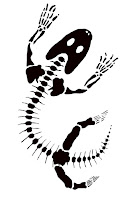Sink Your Teeth Into This Blog

Teeth and Fangs ( other posts ) These Bones Need A Home 1000 Fossil Freaks Care - Become A Fossil Freak One of the rarest prizes discovered at Blue Beach, Nova Scotia Canada is this innocent-looking elongate bone. Along with the slab it was attached to, this is a portion of the lower jaw of a Basal Carboniferous tetrapod. It was the first tetrapod jaw ever found at Blue Beach. It was collected in 1999, loaned to colleagues in 2003 and still remains unreported. For fifteen years this important find has been been buried in obscurity by scientists who haven't got around to describing all the fossils they have. We too are guilty of the same, because h ere at our small museum thousands of fossils have accumulated and there's over a hundred years worth of research awaits. Tetrapod jaw fragment (about 1.5 cm long) with 3 marginal teeth spaced at regular intervals, a narrow dorsal shelf, and a conspicuously striated surface where the dentary encloses


